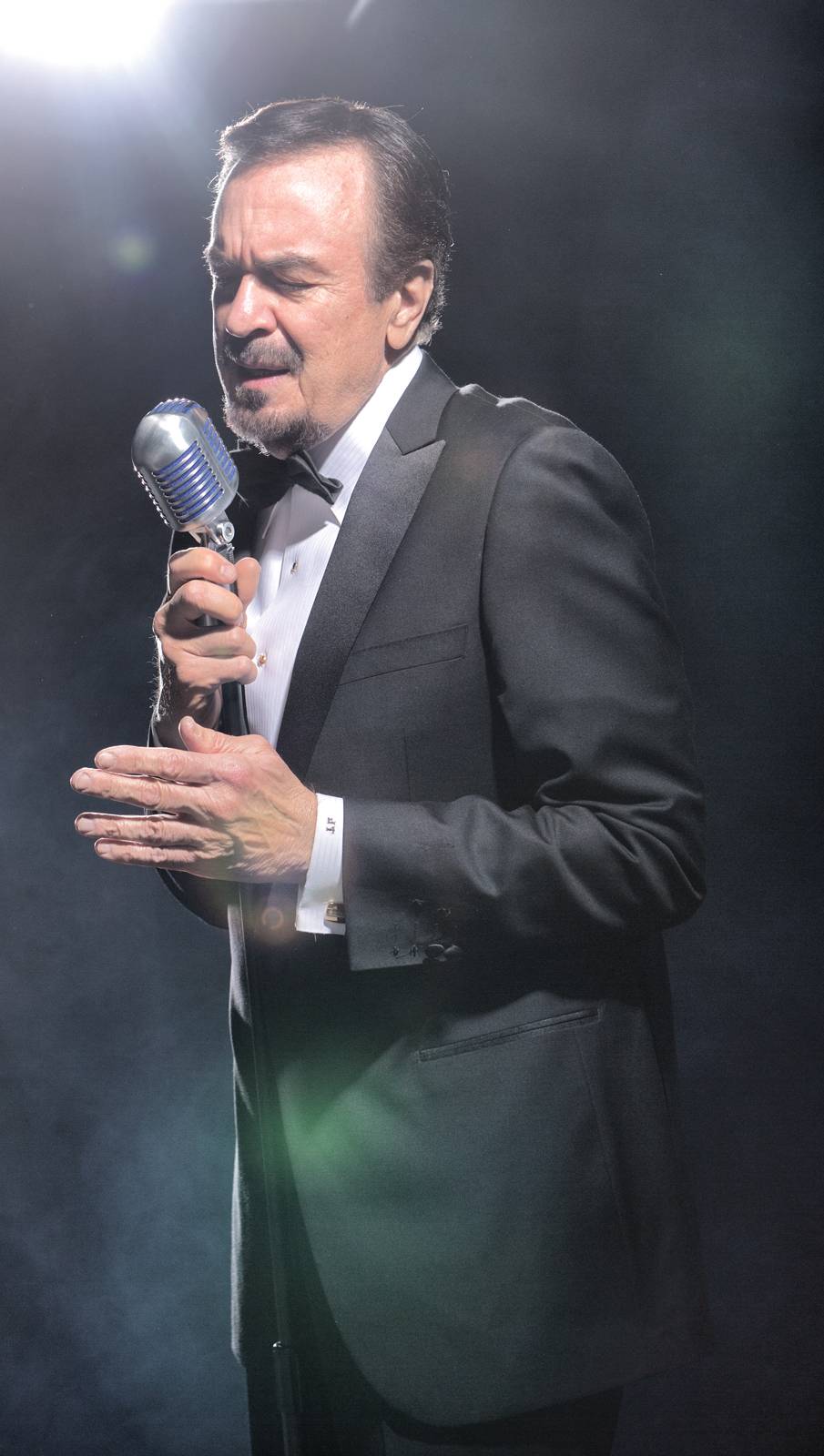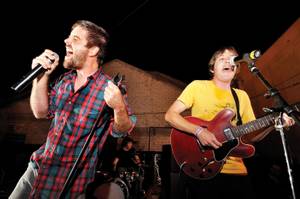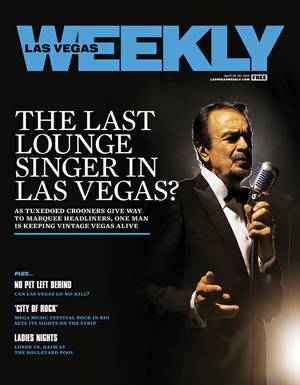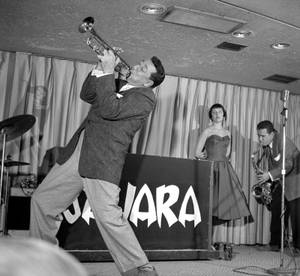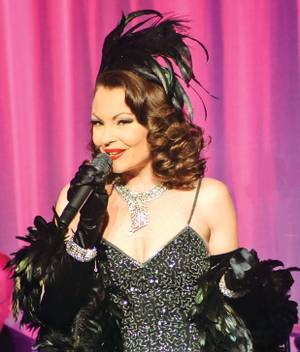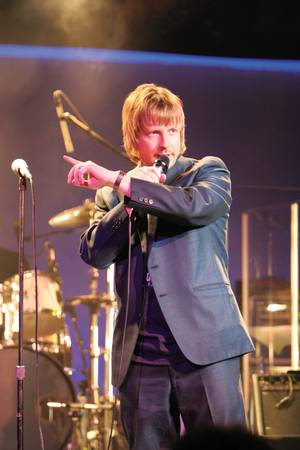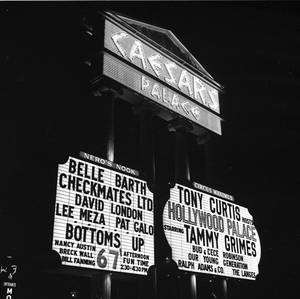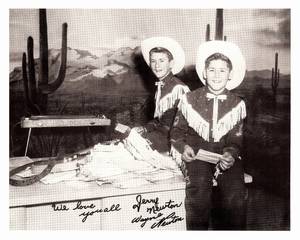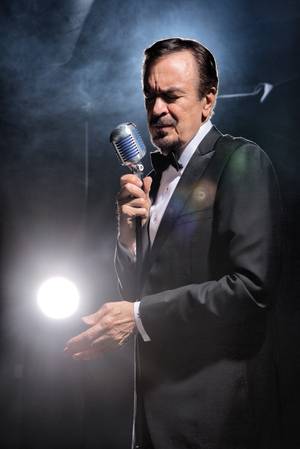The lounge singer strides onstage for his 4 o’clock gig, and man does he look good. The light hits his tuxedoed, 6-foot-3 frame so that he appears in black and white. He stands with a straightened confidence, looking much like a figure in a photo from the Sands hotel-casino way back when.
The lounge singer wears a beard, tightly trimmed; his dark hair is combed afresh. He squints slightly through the spotlight, and as he lifts the mic to his lips his golden cuff links flash. His audience at the Naughty Ladies Saloon at Arizona Charlie’s Decatur numbers about 75, and that might be its median age. It’s filled with afternoon lounge groovers, many of whom have been hitting the saloon since Jerry Tiffe began performing there 20 years ago.
“You got me beggin’ you for mercy,” he sings in a voice famously cloaked in velvet. “I don’t know what you do, but you do it well, I’m under your spell. You got me beggin’ you for mercyyy. Why don’t you release me?”
A half-dozen couples are up, dancing in a swirling, flawless, ballroom-trained sort of way. Tiffe breaks from the vocals to say, “We’ve got Mariano and Lucille celebrating an anniversary here. Round of applause! Round of applause!” And the band carries on.
At age 65, Tiffe embodies the phrase, “They don’t make ’em like this anymore.” He is an icon from a distant past, when top-notch, well-dressed singers unspooled classic entertainment in open lounges simply because it was cool.
“Jerry’s still doing the actual vintage Vegas act, and nobody comes to mind who is doing it who is actually from that era,” says Lon Bronson, frontman of the Lon Bronson All-Star Band, who started his spirited run in Vegas nearly 25 years ago at Le Bistro Theatre at the Riviera.
Jerry Lopez of Santa Fe & The Fat City Horns started his run in Las Vegas Downtown at the lounge at the Mint in 1975. He’s seen every level of lounge performer in the city since then. “Jerry is not an impersonator, replicator or duplicator,” Lopez says. “He is that guy, and that’s what makes him so great.”
Since arriving in Las Vegas in 1978, Tiffe has played the Regency Lounge at the since-leveled Sands, Tropicana’s Atrium Lounge, and the small rooms at the original MGM Grand (now Bally’s), Desert Inn, Riviera, Sam’s Town, Suncoast, Arizona Charlie’s, Aliante and all of Station Casinos’ properties. He’s been so busy over the years, even he has a tough time reciting every hotel in which he has performed. Filing his tax forms for 2013, he was shocked to learn that he’d played 20 lounge residencies in a single year.
Tiffe’s lounge presentation is largely unchanged from when he started performing in cozy venues around his hometown of Cleveland more than 40 years ago. Occasionally he breaks out a trumpet, his chosen instrument, and his setlist varies—“Fly Me to the Moon” followed by “Surfin’ U.S.A.,” “Let the Good Times Roll,” then maybe “I Saw Her Standing There.” The tunes (as Tiffe refers to the songs played onstage) are often determined by the mood of the crowd. But what does not waver is Tiffe’s slick demeanor, his spot-on vocals and his dire desire to win over every crowd.
“You are an entertainer, and you have to get out and put yourself on the line every night,” he says an hour before taking the stage for one of his gigs at the Naughty Ladies Saloon. “One thing about working the lounge: You’ve gotta make something happen. You know what I’m saying? It’s not easy, and if you don’t make something happen, you aren’t doing your job.”
There was a time in Las Vegas when some of the best entertainers were lounge performers. Lounges played such a prominent role in the city’s history, Tiffe’s act could be designated as some sort of historical landmark. With the advent of hotel-casinos on the Strip in the 1950s, stars such as Don Rickles, Shecky Greene, Louis Prima and Keely Smith and The Checkmates filled the city’s lounges. The Prima and Smith shows at Sahara’s Casbar Lounge were legendary for their superstar visitors—The Rat Pack, Jerry Lewis and Nat “King” Cole were among the frequent late-night guests. Vocal impressionist Bob Anderson and his Top of the Dunes was another scene for hepcats from 1975-’85, with Tom Jones and Steve and Eydie and Tony Bennett among the entertainers who dropped by.
But the lofty stature of the Vegas lounge today is mostly history. Still, there are some cool hangs around town: Mark OToole, who survived Stage IV non-Hodgkin lymphoma, has built a strong local following at Sunset Station’s Club Madrid and Rampart Casino’s Addison’s Lounge. He’s also fronting a big band at Cabaret Jazz at the Smith Center on June 3. Laura Shaffer has performed her “Noir Nightingale” shows around town for years, appearing Sunday nights at the Bootlegger Bistro (where she was recently featured on CNN’s Anthony Bourdain: Parts Unknown) and Mondays at the hip Piazza Lounge at Tuscany. Skye Dee Miles and her band Skye5 at Tropicana is among the most popular lounge shows in town (especially among her fellow entertainers).
But those shows don’t represent a rejuvenation for the lounge scene in Las Vegas. The days of those comfy venues featuring high-caliber stars, whether established or rising, has been waning for about 20 years.
“This is pretty much my standard rant,” Bronson says. “Nobody wants to have lounges like they used to in Las Vegas, because they don’t want to spend money.”
The investment in lounges on the Strip began to diminish as corporations seized ownership of so many Vegas resorts. In the old days—that highly romanticized period when organized crime figures served as resort operators and answered only to themselves—there was essentially a single bottom line: Is the hotel-casino making money? If the answer was yes after everybody had been paid, well, let the good times roll and keep the cash flowing to the lounge.
But today, each individual operation inside a casino needs to justify its existence by turning a profit.
“That has been the philosophy for quite some time now,” says Station Casinos Vice President of Entertainment Judy Alberti, who has booked Tiffe over the course of two decades, along with such popular small-venue acts as Bronson, Zowie Bowie, Yellow Brick Road, Nashville Unplugged, Elvis Monroe, Franky Perez and Michael Grimm. “The smaller rooms need to turn a profit. You need the right act that brings in the right demographic to buy drinks and gamble.”
Today, the value of the lounge is measured by whatever cover might be charged (though purists say it isn’t a true lounge if there is a cover at all), plus the bar revenue. But how much money those folks in the lounge drop at the slot machines or table games is an inexact science, and Station has pulled apart one of the great small venues in the city—Ovation at Green Valley Ranch—because the company can make more money with a bingo room.
Similarly, another outstanding lounge, Fontana Bar at Bellagio, which overlooked the hotel’s water show and showcased such well-received performers as Dian Diaz and Jimmy Hopper, was closed in favor of Hyde nightclub. That meant Diaz left Vegas for Florida, and Hopper toured nationally before returning to town, first with a weekend dinner show at Bootlegger and more recently at Orchid Lounge at Mandalay Bay.
Historically, entertainment directors and entertainers themselves have learned that beverage revenue doesn’t always translate to gaming revenue on the floor. An audience nearing age 70 isn’t likely to drink a lot, but it may hit the slots after the show.
“The problem is, the casinos have compartmentalized every department too much, and all they care about is the bottom line from each of those individual departments,” Bronson says. “In the old days, they didn’t care where they got the traffic, as long as there was traffic in the casino and the casino, as a whole, made money. It’s no longer a single team, it’s individual players, and it hurts the quality of entertainment because they’ve watered down the money, and the entertainers are playing six to seven sets for nothing, so now the quality of entertainment in the lounge sucks. Believe me, I have been beating my head against the wall for 20 years about this.”
Bronson is quick to help define what, exactly, a lounge is. He himself plays Club Madrid at Sunset Station and the Railhead at Boulder Station, both of which are more akin to small showrooms than traditional lounges. Santa Fe plays the Lounge at the Palms, a ticketed performance that is also not exactly a lounge presentation.
“There should be fluid entry and exit, where pretty much any kind of behavior is acceptable,” Bronson says. “You should be able to dance, yell requests, be asked to sit in with the band. You need cocktail waitresses working the room.”
Over the past 15 or so years, Hopper, Earl Turner, The Scintas and Frankie Moreno are among the more memorable Vegas entertainers who have managed the move from lounge shows to showroom or ticketed residencies. Results have varied. The Scintas, who opened at the then-Hilton’s Shimmer Cabaret in 2000, are now Downtown at the D. Turner, once a lounge sensation at the Rio, continues to play a few weekends a year at the Suncoast but spends most of his time on cruise ships. Hopper, who also started at the Rio before he moved to the Fontana Bar, is in the lounge at Mandalay Bay. Moreno has been one of the more notable successes, following lounge-like bookings at the Golden Nugget and Palms with his own showroom act at the Stratosphere.
Some acts have performed in the lounge almost coincidentally while achieving a measure of national fame. Michael Grimm won his spot on America’s Got Talent through a riveting TV audition, not because he was discovered at Ovation or Hank’s at Green Valley Ranch. The same goes for Perez, who has toured with Camp Freddy and recorded original songs for Sons of Anarchy outside the scope of his appearances in Vegas lounges.
Many acts, like Bronson, Santa Fe and Matt Goss’ show at Caesars Palace in the old Cleopatra’s Barge, are somewhere in between the lounge and the showroom, occupying a tricky middle ground. Santa Fe’s Lopez says Vegas lounges are suffering not just because of meager investment, but because live entertainers aren’t as valued by today’s Vegas consumers.
“What has happened is the music business has changed, so the music has changed,” he says. “Now instead of kick-ass bands in lounges, the generation that used to go to the lounges are now going to the big nightclubs, where they are watching DJs with thumb drives and laptops who don’t have a lifetime of musical training behind them. Music has become devalued, and when people don’t value the entertainers, the whole industry suffers, including the lounges.”
Perhaps the leading expert on the history of lounge performing is Mr. Las Vegas himself, Wayne Newton. What might have been lost through Newton’s 55-year career in the city is that he was the original locals’ act. When he moved out of the lounge at the Fremont Hotel to the Flamingo Showroom in 1962, there was such skepticism about his viability that Strip execs were betting an over-under on whether he would fulfill his original two-week contract.
“But the locals, they came out in droves,” Newton recalls.
This was the era when legends like Rickles and Prima were enjoyed for free around the city. “You could sit there for six hours, order one drink for 65 cents, and see these entertainers,” Newton recalls. “For a lot of us—Louis, Keely, Rickles, Shecky—it was the training ground. The farm team, on your way to the big leagues.”
Newton certainly survived some of the wildest lounge shows ever in Las Vegas during his six-year run at the Fremont Hotel’s Carnival Lounge, where he and his brother, Jerry, performed six shows a night six days a week, starting at 5 p.m. and carrying through to the early morning.
“I have no doubt whatsoever, whatever I am is a direct result of those six years in the lounge,” he says. “If it could happen, it did happen. I saw it all. I learned how to adapt to anything happening from the audience.”
Newton was frequently flashed by women who wobbled into his performances. Once, when singing the famous Christian number, “I’ve Got the Joy Joy Joy Joy,” Newton ducked a beer bottle flung from the audience.
“The guy thought it was blasphemous to sing that song in a casino,” Newton recalls. “We also had a guy die on us one night who wasn’t carrying his driver’s license. No one knew who he was. We didn’t know what to do with him, so we wrapped him in carpet and took him backstage. We had to step over him between shows.”
While opening for Jayne Mansfield, who happened to be both drunk (on purpose) and topless (accidentally, in what might have been the first-ever wardrobe malfunction), Newton was called to the stage to handle a rowdy audience. He dropped the mic and sang “Danny Boy” a cappella.
“You learn how to cope when you are holding an audience,” Newton says. “And you need to give the people seeing you a reason to come back.”
Newton smiles remembering his four-piece act making $500 a week. Sometimes he was asked to start his gig at 6 a.m. and perform through noon.
“From 6 a.m. to noon, you’d get the people who had been up all night until 9:30 or so, and then they’d pass out or get thrown out,” he recalls. “Then, from 9:30-10, it was dead. Then at about 11, your new drunks would get going and come in … It was cyclical, yes.”
But Newton did learn a lot about various forms of entertainment while working the lounge. “We were basically a country act from Arizona, but we saw many groups, a lot of them doing the choreography that would be popular later with a lot of the Motown acts,” he says. “We had Freddie Bell & The Bellboys, Joe King & The Zaniacs, a lot of acts from Philadelphia came in … I saw a lot for the first time. The first time I’d seen guys with padded crotches was in the lounge.”
Newton laughs again, seeming almost sentimental, nostalgic for those days at the Carnival Lounge. Does he ever miss them?
“No,” he says. “God, no.”
When Newton played the Copa Room at the Sands in the late-’70s, the line of fans leading to his show stretched back all the way to the hotel’s Regency Lounge, where a captive audience watched the Sands’ hot lounge act of the day.
Jerry Tiffe was his name.
“Wayne’s audience was my audience,” Tiffe says. “The lounge was set up that way in the casino. If you wanted to eat at the Regency Gourmet Room, you had to walk by the lounge.”
Blessed with an innate ability to harmonize, the young Tiffe was first a singer in a four-part vocal group called the Magic Times. (Tiffe’s group sang background on The Outsiders’ hit “Time Won’t Let Me,” which reached No. 5 on the Billboard charts in 1966.) He put together a little band and began playing the college-bar circuit, where a well-known keyboard player from Cleveland, Gene Lamarca, took notice of the frontman. Lamarca pulled Tiffe aside and made him an offer: Learn some standards from the Great American Songbook and take over the Ramada Inn lounge that Lamarca happened to own.
“He bought me a suit and tie, and now I’m a lounge guy,” Tiffe says, opening his arms as if to emphasize that the image hasn’t changed. “After a week, he hands me an envelope, and there’s $150 in there, one week’s pay for playing the Ramada Inn.”
Tiffe was stunned. “What’s this?” he asked.
Lamarca shot back, “Whatsamatter, not enough?”
Oh, it was plenty. That $150 cash payment changed Tiffe’s life.
“I was saying, ‘You mean I can make $150 a week? For doing this?’ he says. “That was it. I’ve been in lounges ever since.”
Today, we are a long way from the days of the Sands, where Tiffe was handed his first five-year contract and asked to win the audience over, night after night. He gazes to the heavens as if asking for divine guidance to remember what those times were like.
“It was just comfortable, you know? There was just such a comfortable feeling about the place,” he says. “There was no heat there. Everybody was relaxed. The customers. The bosses. Everybody was so cool.”
Or maybe we’re not so far from those days.
Tiffe softly snaps his fingers, as if to snap back to reality. The lounge singer is through talking. He straightens his bow tie and opens the curtain, ready to hold that audience, one more time.
